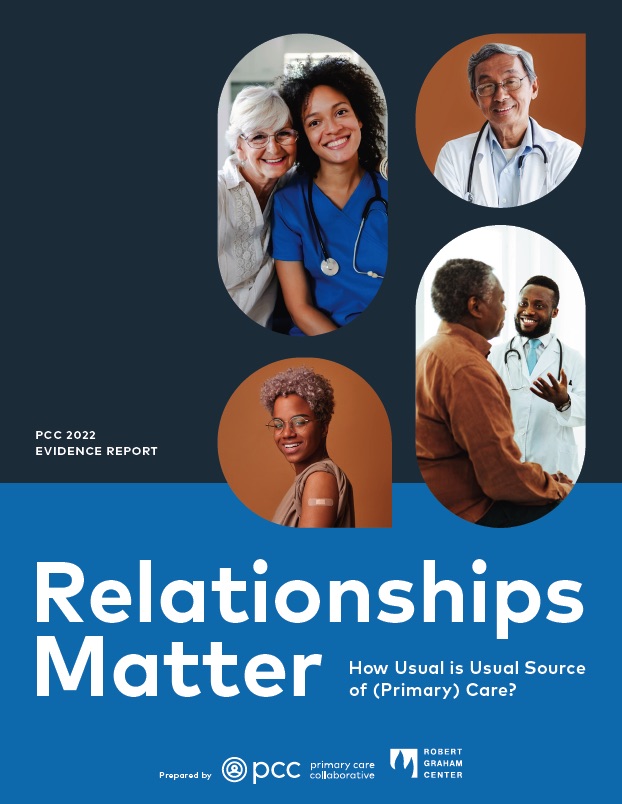You are looking at an archived version of our site. Please visit thepcc.org for a fresh, new experience!
Is Fee-for-Service Compatible with Comprehensive Primary Care?
On May 28, 2024, the Primary Care Collaborative (PCC) held a webinar exploring how policymakers can reform Medicare payment structures to strengthen and improve access to high-quality, comprehensive primary care.
Speakers included Amol S Navathe, professor at the University of Pennsylvania Perelman School of Medicine and Vice Chair of MEDPAC; Cristina Boccuti, Vice-President of Health Security at the AARP Public Policy Institute; Melanie Matthews, the CEO of PSW; and was moderated by Peter Long, Executive Vice President of Strategy and Health Solutions at Blue Shield of California and member of PCC's Board of Directors.
The conversation began with an exploration of the existing Medicare Fee Schedule and how it undermines patients’ access to high-quality primary care.
There was a consensus among the speakers that, while the current Medicare Fee Structure was designed with the noble intention of standardizing documentation and paying for vital health care services under Medicare, it has failed to evolve in an increasingly complex health care system and now contributes to major challenges in providing patients with comprehensive primary care.
Panelists noted the existing fee-for-service payment structure often encourages fragmented care, especially for those with multiple chronic conditions. Speakers also emphasized that the current Fee Schedule fails to account for many activities clinicians need to perform during and after visits to manage patients’ health effectively—and that attempts to address that shortfall have led to the creation of an overwhelming amount of billing codes that ultimately become an even larger documentation burden on clinicians.
The panel also noted that the current fee-for-service structure often also forces patients with chronic conditions to repeatedly pay cost-sharing for visits—a challenge that not only places unfair financial burdens on those patients, but that also may discourage them from seeking necessary care. Speakers agreed that any solution to the fee schedule also needs to adjust upfront costs for patients.
The conversation then shifted to potential solutions for reforming how Medicare pays for quality of care.
PSW’s Melanie Matthews explained that alternative payment models that already exist in Medicare have demonstrated there’s a smarter, more effective way to pay for primary care—but that there needs to be a larger, more systemic shift toward population-based payment models.
Panelists then discussed the potential of hybrid payments—an approach that the Primary Care Collaborative and it’s Better Health – NOW Partners have advocated for, helping lead to the launch of the new ACO PC Flex model by the CMS Innovation Center.
Lawmakers have increasingly shown interest in this approach as well, with the introduction of a bipartisan bill by Sens. Whitehouse (D-RI) and Cassidy (R-LA) and the release of a white paper on payment reform by the Senate Finance Committee.
The panelists agreed that a hybrid approach that melds some traditional fee-for-service compensation with population-based payments could provide primary care practices the flexibility and financial support needed to build full primary care teams and give clinicians more breathing room to focus on providing care rather than billing.
Peter Long noted that Blue Shield of California—a private payer—had implemented a hybrid approach in many of their contracts, and that early results suggested hybrid payments can help stabilize and provide financial security to primary care practices.
Ultimately, speakers agreed that committing to developing and explore more alternative payment approaches—especially hybrid payments—held a lot of promise and were an important step to bolstering patients’ access to primary care, although they were unlikely to be a panacea.
Resources
- What to know About How Medicare Pays Physicians - Kaiser Family Foundation
- Medicare Stumbles Managing a Costly Problem—Chronic Illness - KFF Health News
- Dr. Navathe’s and Melanie Matthews’ testimony before the Senate Finance Committee, April 11, 2024
- Medicare Physician Fee Schedule Reform: Structural Topics and Recommendations to Strengthen the System for the Future - HMA
This webinar is made possible with support from:
Professor, Perelman School of Medicine, University of Pennsylvania
Amol Navathe, M.D., Ph.D., is founding director of The Parity Center, codirector of the Healthcare Transformation Institute, and associate director of the Center for Health Incentives and Behavioral Economics in the Department of Medical Ethics and Health Policy at the University of Pennsylvania’s Perelman School of Medicine. He is also an professor at Penn and staff physician at the Corporal Michael J. Crescenz VA Medical Center in Philadelphia, PA. Dr. Navathe’s research group designs, tests, and evaluates payment models for public and private payers, including national insurers and state Blue Cross Blue Shield plans. His work led to the founding of Embedded Healthcare, a healthcare technology company that accelerates high-value practice using behavioral economics. Dr. Navathe received his M.D. read more
Vice-President, Health Security, AARP Public Policy Institute
Cristina Boccuti is Vice President of Health Security at the AARP Public Policy Institute. In this role, she leads a team of senior health policy professionals to deliver research and analysis that drives and supports the public policy priorities, advocacy efforts, issue campaigns, and communication activities that advance AARP’s work on behalf of older adults. read more
CEO, Physicians of Southwest Washington
Melanie is an esteemed healthcare executive with a distinguished career spanning over 27 years. As CEO of PSW and President of MultiCare Connected Care (MCC), she has led transformative initiatives in value-based care and diversified PSW’s business lines to include various advisory and management services such as credentialing, compliance, and implementation of CMS innovative payment models. read more
Executive Vice President, Strategy and Health Solutions, Blue Shield of California
Peter Long is executive vice president for health solutions and Chief Strategy Officer at Blue Shield of California, a nonprofit health plan with over $24 billion in annual revenue, serving over 4.8 million members in the state's commercial, individual, and government markets.
Long is responsible for strategies to achieve the health plan’s vision of creating a healthcare system that is worthy of family and friends and is sustainably affordable. This work includes collaborations with healthcare providers, community leaders, and other stakeholders to design innovative clinical and community programs, healthcare delivery, and payment systems that provide all Californians access to value-based, high-quality, and affordable care. read more
What's New
August 16, 2024
- Page 1
- ››










